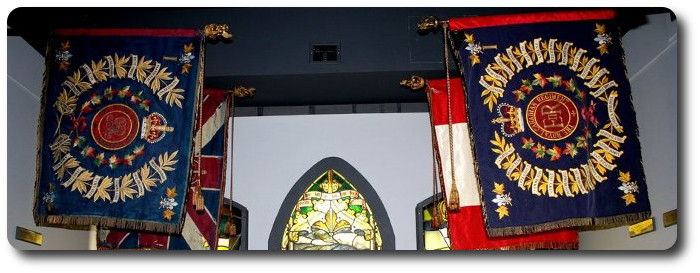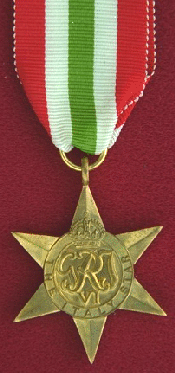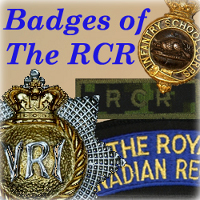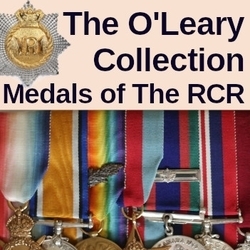
Researching The Royal Canadian Regiment

The Italy Star was awarded for one day operational service in Sicily or Italy between 11 June 1943 and 08 May 1945.
"D" Day Sicily, 10 July 43
By: LCol Ian Hodson, TC-42051
Pro Patria, Issue No. 74, April 1993
"D" Day Sicily was a day which seemed to have no beginning or ending. When did the day start? When did it finish?
Aboard the Dutch ship Van St Aldegonde de Marnix was the bulk of The Royal Canadian Regiment, geared to make the initial assault landing on the beach near Pachino, in the Southeast comer of Sicily. We had two objectives: first, to get across the beach in reasonable operational order and then to secure the airstrip at Pachino. This airstrip was all important because supporting fighter aircraft, operating from Malta, carried only enough fuel to be over the beach for a few minutes at a time. Further inland was beyond their range. Possession of the Pachino airstrip was a must.
After a month on board the Marnix, we had run the gauntlet through Gibraltar and were off Malta, with a day to go. We were told there was a storm ( I was already seasick), that the storm had built up a sand bar 100 yards off the beach, that the assault boats might not be able to cross the sand bar , that there might to eight to ten feet of water between the bar and the beach and therefore OUKWs had been ordered, for only the two forward companies, "C: and "0". They had been ordered from Alexandria to be brought alongside the LCTs. My "C" Company had been allotted six OUKWs. Four months of repetitive training in seven serials was down the drain! We hastily reorganized our officers and men, and the two sappers into six serials.
At 0200 on the 10th troops were to move from their mess decks to their boat stations. Before this, there was last minute instructions (with "C" Company rehearsals), another machine gun position had been reported on our beach (which amused Strome Galloway) plus breakfast, plus getting on our gear with which we were amply provided. In other words, after a busy day on the 9th, no sleep.
While every bit of gear had a purpose, it collectively hampered any idea of hitting the ground and rolling for cover if fired upon. Regardless, here we were, well equipped and accoutered, ready for the big show.
Just before landing, the battalion was offered 20 new style steel helmets for use by the more senior officers. With one accord the four rifle company commanders declined, gracefully but firmly.
At 0200 aboard the good ship Marnix, troops were on the move. Over the public address system Tommy Cantley, our movement officer, in his best New Glasgow accent, shouted "Serials 12, 13 and 14, to your boat station NAOWWW". We were on our way!
For some reason I can't remember, I brought up the rear of the company. Going through "C" Company mess deck, I was appalled to see an enormous pile of equipment in the middle of the deck -sections of bangalore torpedoes, spare bren gun barrels, respirators, ammunition, mortar bombs, the whole schmeer. Had the platoon commanders been present, I would have castrated them on the spot, particularly after their performance some weeks earlier. My only consolation was that our route took us through another mess deck, where there was another identical pile.
"A" and "B" Companies embarked in their assault craft. Nobody explained to me what they would do if there was indeed a sand bar, too shallow for their craft to cross, or explained what support I could count on if I landed from DUKWs and the follow-up company could not.
Once "A" and "B" were water borne our LCTs came along side, with some delay. There was very strong swell from the storm. The Marnix was a large ship and didn't budge in the swell. The LCTs however, rose and fell a good ten feet. To get the troops aboard we had a rope net from the deck down to the LCT. As the LCT rose, the net swung loose. When the LCT fell, the net tightened like a bow string. Picture some of the soldiers carrying awkward equipment like bren guns, mortars, PIA Ts, bangalore torpedoes, 18 Sets, climbing down this obstacle, in the dark. We lost no equipment, we lost no men, but we did lose time.
When I got into the LCT I found my allocation of DUKWs had now been reduced to five, not the six to which it had already been reduced. Confusion! Shouts! Somehow we packed them all in, 27 men to a vehicle. We were grossly overloaded. Since a DUKW is made of thin aluminum and plywood, there was no protection whatever from small arms fire. However, off we went, by this time in broad daylight, about 2 hours late, out the front ramp.
Around us circle " A " and "B" Companies in their assault craft. They had been waterborne for at least an hour. One platoon, believing it was going to land in the dark had blackened its faces. They looked somewhat incongruous, especially those who were seasick and had the consequent green complexions.
Behind us, about one mile away, the monitor HMS Roberts fired over our heads with its two 15 inch guns. We could follow the shells going inland. The noise was tremendous and the blast made our DUKWs settle in the water and then surge forward. Somewhat frightening!
We headed for the beach. We saw no sign of the sand bar. We drove up onto the sand and landed dry shod. I found myself beside a large hole in the sand in which were two photographers and piles of films. When and how did they get there? There were no signs of enemy, no shots had been fired. We organized ourselves and headed for the Pachino airstrip. Incidentally, for the Canadian Forces in this landing, "C" Company of the RCR was the "right of the line" .
To one side was a miserable farm house surrounded by patches of cactus (eaten fried in olive oil by many Sicilians). From the farm house emerged the farmer, who it turned out had spent 17 years in Toronto, had made his pile and returned to his homeland to buy his dream house. Greetings and reminiscences caused some delay.
Our movement to the airfield was not carried out in any prescribed military fashion. One platoon commander saw something about 1000 yards away and without reference to his Company Commander or his Platoon Sergeant, had disappeared to investigate. His Platoon Sergeant, who was not the brightest, was nonplussed as to what to do with the platoon. It took some energy and some strong language to straighten him out, and later the Platoon Commander .
While this was happening, the other platoons had found a dead Italian soldier. They immediately gathered around like flies around a fresh pasture paddy, cutting off buttons, epaulettes, belt buckle, etc. Further confusion and delay while we pushed the platoon commanders to get busy and command their platoons.
Arriving at the edge of the airstrip, we detailed on platoon to cross, covered by a second platoon, while awaiting the return of the missing platoon commander. He arrived, to receive a warm welcome. We spent a few minutes getting him and his platoon organized. Looking across the airstrip, I was horrified to see our leading platoon sitting in a circle in the middle of the landing strip, having a rest and a cigarette. At the far end of the airstrip,' on our left, and about 1000 yards to the west, Slim Liddell was putting his Company across, and was being subjected to artillery fire from an Italian Battery . This Battery was taken shortly after , with some casualties.
Back to "C" Company. I With shouts and signals, our progress, across the strip continued without further incident. Within minutes Royal Engineers were repairing and making ready for the first aircraft. I believe these arrived only three or four hours after we had cleared the field.
A mile or two beyond the field we were instructed to halt our advance. This was welcome news to those of us who were still recovering from seasickness. The heat was being felt. It had been about 70 -75 degrees out on the water, but was now pushing 90-95 degrees. The Company stopped in the shade of a long row of cactus which stood about 10 feet high. The troops were tired and there was dead silence. Suddenly, from nowhere, appeared an Italian soldier leading a mule on which was a very large wireless set. The Italian had not seen us and plodded along parallel to our line of recumbent soldiers, about 50 feet in front of us. No shots were fired, no sentries were calling out to their superiors to point out this soldier, Finally I got to my feet and shouted "Platoon Commanders, For God's sake, somebody, do something." There were a few shouts, followed by some sporadic rifle fire. The Italian kept plodding along. Finallya soldier ran after him, knelt down and shot him. Not a very auspicious occasion.
In the distance - east - we saw some strange looking tanks. These scared the Hell out of me. By memory I ransacked the silhouette cards we had had in training to recognize AFVs, but could recall nothing like these. They turned out to be the armour from the desert in support of the 51st Highland Division. When we got close to the Highlanders, we saw that they wore flannel shirts and every man carried a pick and shovel. Our troops ridiculed the Brits for their apparel and extra equipment. It was ironic because we found that the flannel absorbed the sweat by day and gave some warmth by night, unlike our thin bush shirts. And after being exposed to competent enemy fire, miraculously we too acquired picks and shovels and were glad to carry them. They did a better job than fingernails and the edge of a steel helmet digging weapon pits.
Sometime during the afternoon we picked up some Italian prisoners. I can't recall having to fight to acquire them. One rather elderly NCO in broken English, explained that they belonged to the King's Army (Emmanuel) and not Mussoline's, and had no desire to fight friends. The official history credits the company with capture 100, but I have no recollection of that number .
At dusk, we stopped for the night, ostensibly to enable Brigade to get sorted out, to wait for supplies to accumulate on the beach heads and to wait for transport to be brought ashore. During the night there was a furious exchange of small arms fire somewhere off in the darkness. Later it seemed that battalion HQ had taken on one of our rifle companies. There were no casualties.
Off at sea, just before dusk we could see ships in both directions virtually to the horizon. At night curtains of red flack went up from the hips against the odd enemy bomber. It was a most astonishing and impressive sight. We understand there were close to 2200 ships in this whole operation.
Few of us slept that night, even when we had the opportunity.
It had been a remarkably easy introduction to battle for any unit. The Germans had stockpiled wire and mines, had developed a defensive fire plan, but had not had the time to implement their plans. The Italians, in the main, had had enough of war. We had no casualties, gained some experience (some of it admittedly not very good) but we were intact and ready for the next operation. Men had learned for themselves that in this heat we could not carry all the equipment issued us. Without instructions or authority, on that very first day and during the next few days, we stripped down to the very basic necessities to become mobile and to conserve energy. We all recognized that we had a great deal to learn, but we had taken a first step toward become good soldiers.
"D" Day, 10 July 1943 was behind us. When had the day started. When had it ended. It had been a VERY long day indeed!


